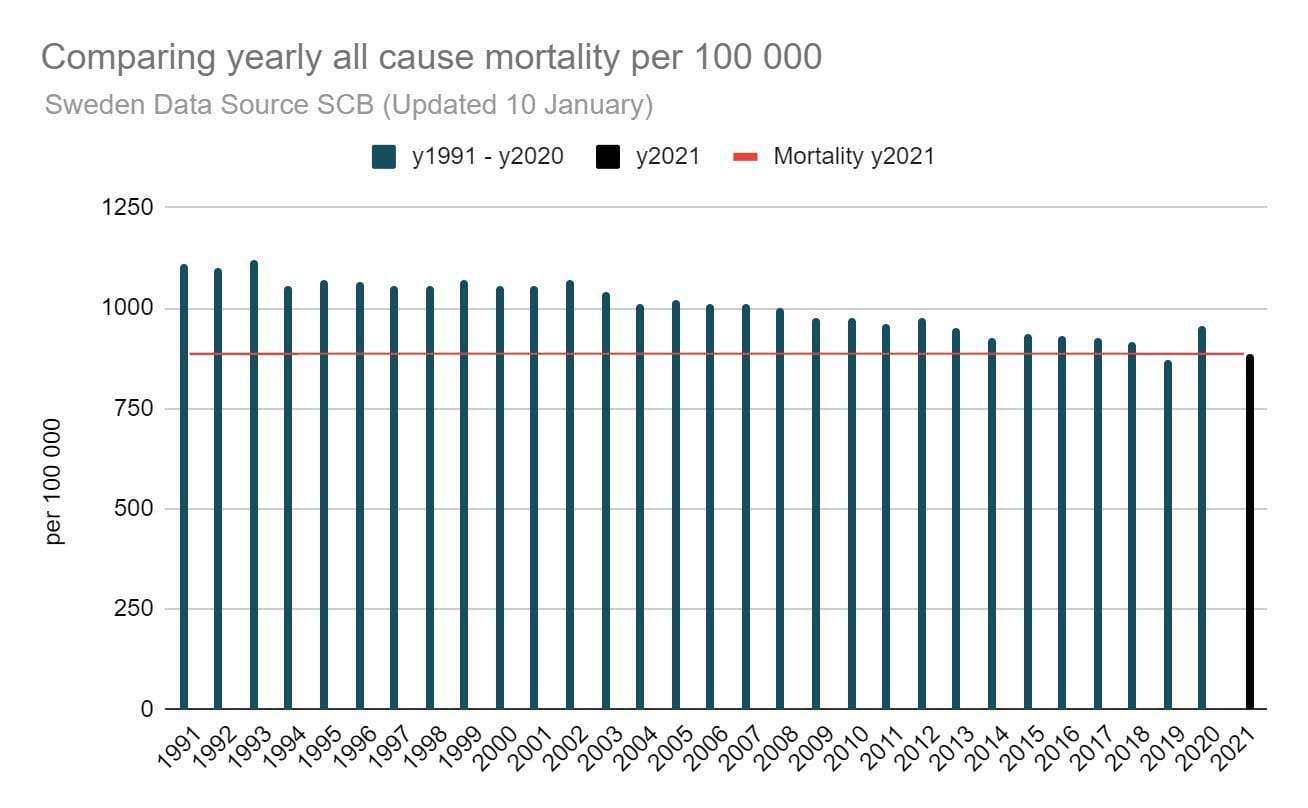Sebastian Rushworth M.D.
sebastianrushworth.com
I work as a junior physician in Stockholm, Sweden. I studied medicine at the Karolinska Institute and graduated in January 2020.
I am a proponent of evidence-based medicine. In other words, I think that medical diagnosis and treatment should be guided by the scientific evidence, not by expert opinion or personal anecdote, and certainly not by salespeople working for pharmaceutical companies.
The Swedish government has decided to end all covid related restrictions from the 9th of February. Additionally, venues and events will no longer be able to demand proof of vaccination. To top it off, the public health agency is recommending that covid no longer officially be classed as a “threat to public health”. Sweden is the third Nordic country to end covid restrictions, following on the heels of Denmark and Norway.
The decision represents an acceptance of the fact that covid has gone from being a pandemic to an endemic disease. The public health agency estimates that 500,000 Swedes were infected with covid-19 last week (which is twice the number of confirmed cases). At the same time, only 181 people died of/with the disease (possibly more “with” than “of”). That puts the present lethality of covid in the same ballpark as the common cold. As many people have long predicted, covid-19 has become the fifth “common cold” coronavirus disease.
Now that the pandemic is officially over, I think it’s interesting to go back and look at how bad it actually was. Before we do, let’s remember that Sweden has taken a light touch throughout the pandemic. That means it serves as a useful “control” in terms of understanding what would have happened if a country didn’t impose lockdowns, close schools, and force everyone to wear masks.
If we want to understand how deadly the pandemic was, then the best metric to look at is overall mortality. It is the only metric that cannot easily be manipulated. “Covid deaths” is not a good metric, because it is open to interpretation. Different doctors, different hospitals, and different countries define covid deaths differently. And often in official statistics “deaths with covid” (i.e. deaths from other causes but where the person happened to have covid or at least a positive covid test) are defined as “covid deaths”, which makes it hard to determine how deadly the disease actually is.
The Swedish government statistics bureau (SCB) makes excellent statistics, possibly the most reliable official statistics in the world. And Harold on Twitter has been producing very helpful graphs based on these statistics. Here is Sweden’s overall mortality year on year from 1991 to 2021, courtesy of SCB and Harold.

What do we see?
Well, we see a gradually declining overall mortality over the thirty year period, from roughly 1,100 deaths per 100,000 during the early 1990’s down to an average of roughly 900 deaths per 100,000 during the last five years. This decrease is likely mostly due to the fact that life expectancy in Sweden has increased significantly over the thirty year period, from 78 in 1991 to 83 today.
Next, we see an unusually low overall mortality in 2019. This made Sweden “ripe” for a worse than average year in 2020, just due to the simple fact that years with less than average mortality are usually followed by years with more than average mortality (because a year with less than average mortality means there are more very frail people on the verge of death at the beginning of the next year). We can see this in the graph above – when there is a big drop in mortality in one year, it is usually followed by a rise in mortality in the following year. So 2020 was always likely to have a little higher than average mortality.
Then we come to 2020, and we do see an effect of the pandemic (in combination with the expected slightly higher than average mortality), with an overall mortality that is roughly 945 per 100,000 people, as compared with the average for the preceding five years, which is 900 per 100,000 people. So, in 2020 there were 45 extra deaths per 100,000 people as compared with the average for the preceding five years, which represents roughly 4,600 people. What that means is that the pandemic, in combination with the fact that 2020 was following on a year with unusually low overall mortality, resulted in something like 4,600 extra deaths, which represents 0,04% of Sweden’s population.
What can we conclude?
Yes, there was a small bump in mortality in 2020 due to covid, but it was pretty damn small. I’m not saying covid isn’t serious for some segments of the population, but all claims that this was a hugely deadly pandemic on par with the Spanish flu are clearly massively overblown. That becomes particularly obvious when we move on and look at 2021. As is clear from the graph above, there was no excess mortality whatsoever in 2021. In fact, 2021 was the second least deadly year in Swedish history!
That is in spite of the fact that official statistics show an additional 6,000 deaths with/of covid in Sweden in 2021. Clearly, most of those 6,000 were either deaths “with” rather than “of”, or the people who died of covid were for the most part so close to death that they would have died in 2021 anyway, even without covid.
When we break the data down by month (again courtesy of Harold and SCB), we see something interesting. Here’s the graph:

What we see is that there was excess mortality in Sweden from April to June 2020, and then again from November 2020 to January 2021. For all other months over the two year period, mortality has been lower than what would have been expected. So the excess deaths caused by the virus were actually concentrated around two short periods, one in late spring of 2020, and another in winter of 2020/2021. Outside those short periods, there really wasn’t much going on. The Swedish government has officially declared the end of the pandemic now, but if you look at the overall mortality statistics, it really looks like the pandemic ended a year ago.
So, that is how bad covid was in Sweden, the country that never locked down, and that was widely derided as a “pariah state” during the early part of the pandemic. When we look at the overall mortality statistics, and see the number of people that actually died, it’s clear that Sweden was probably the country that reacted most sensibly of all to the pandemic, with measures that were largely proportionate to the size of the threat. The rest of the world instead went around swatting flies with sledge hammers.
One thing that is interesting to think about in light of this, is what the overall mortality data looks like in other countries. Since Sweden, which didn’t lock down, had only marginal excess mortality in 2020, and no excess mortality in 2021, it’s clear that covid-19 itself hasn’t done much damage. That means that any excess mortality beyond the little seen in Sweden in countries that did lock down cannot be due to the virus itself. It must due to something else. Since the one thing that has differed between Sweden and those other countries over the two year period is the absence vs presence of lockdowns, any such excess mortality can almost certainly be explained by lockdowns.
Let’s take the US as an example. Unlike Sweden, large parts of the US instituted draconian lockdowns. Did those lockdowns prevent any covid deaths? Well, If we just look at the crude numbers, we don’t see any reduction. According to official statistics, 0.27% of the US population has so far died of/with covid, compared with only 0.16% of the Swedish population – in spite of lockdowns, the US has had significantly more covid deaths than Sweden!
This is in line with the mass of evidence showing that lockdowns are ineffective. So, since we now know that lockdowns are ineffective at stopping the virus, we would expect that the US would see an effect of the pandemic on overall mortality that is similar to Sweden – i.e. a small increase in overall mortality is expected. If, on the other hand, we see a much larger increase in the US than we see in Sweden, then that increase is likely due to lockdowns. So, what do we see?
Well, here’s a graph of overall mortality for the last seven years that uses data from the CDC:

We see an increase in overall mortality in 2020 and 2021 that is significantly bigger than that seen in Sweden. In Sweden, the relative increase in overall mortality for 2020-2021, when compared with the preceding five years, is 1% (from an average of 900 deaths per 100,000 in 2015-2019 to an average of 912 deaths per 100,000 in 2020-2021).
In the US, the relative increase in overall mortality is 18%! (from 860 deaths per 100,000 in 2015-2019 to 1016 deaths per 100,000 in 2020-2021). That is an 18-fold greater increase in mortality during the two years of the pandemic in the US than in Sweden!
So, to sum up, the US has less than twice as many covid deaths as Sweden (As mentioned, 0.27% of the US population vs 0.16% of Sweden’s population), but 18 times as many excess deaths! Clearly, that massive difference cannot be explained by the virus. It must be explained by something else. The only reasonable explanation, as far as I can see, is that it is due to the disastrous effect of lockdowns on public health. It will be interesting to see whether the US people hold their political leaders accountable for this massively destructive error in judgment over the coming years.








